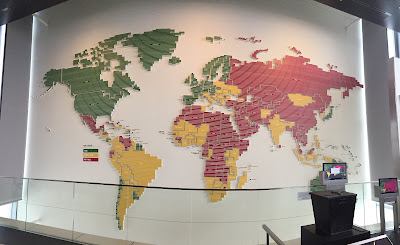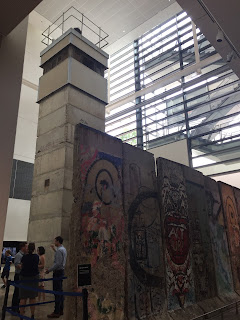
In May, I applied for and was accepted to the
NewseumED Summer Teacher Institute on "Truth, Lies and Consequences: Real Media Literacy for a Fake News World". What immediately drew me to this institute was the focus on media literacy especially as an 8th grade U.S. History teacher. The new
California History-Social Science Framework adopted in 2016 now focuses more on content, inquiry, literacy, and citizenship. It fit perfectly with the goals of the NewseumED Summer Teacher Institute in helping me gain strategies incorporating media literacy in my classroom with an emphasis on citizenship.
This three-day institute was thoughtfully designed and structured to support the different experiences and needs of the attendees. In our cohort, we had ELA, history/social studies, librarians, media techs, and even a math teacher all working towards the goal of finding better ways to teach and incorporate media literacy in our classrooms or schools.
 |
| The 2017 Summer Institute #NEDucators |
Institute Overarching Goal: Adapt the content, tools and strategies presented in order to broaden and/or deepen your media literacy teaching and support in ways that will benefit your students and your peers.
Institute Guiding Questions:
- What skills, knowledge and strategies do students need to be informed and empowered citizens in a media-rich world?
- How can educators incorporate this content in novel and effective ways and overcome potential obstacles?
Day 1 - Fighting Fake News
What tools can students use to effectively and efficiently navigate their media-dense world?
Our first activity on Day 1 was conducted by the
NewseumED Media Literacy Maven herself, Katharine Kosin. We started with defining "fake news" and discussed what was and wasn't considered "fake news". A great activity shared was a Mad Libs-like activity where we provided parts of speech for a newspaper headline to illustrate how easy it is to create a juicy fake headline based on an actual newspaper headline. We then worked in small groups to see if we could identify whether a headline was real or fake using the E.S.C.A.P.E. method provided on a poster by NewseumED. This was a great activity that I could definitely see myself using in my class introducing to my students how to analyze and evaluate news to see whether or not it was fake.
Following lunch, we met Kat Wilmot, the Newseum archivist (coolest job ever!) and we got the opportunity to look at historical fake news. One of my favorite examples was during the Civil War when a northern newspaper falsely printed that the Union won the Battle of Bull Run. On the other hand, the Confederate newspaper falsified the number of casualties despite printing the correct outcome of that battle.
 |
| Conflicting information about the Battle of Bull Run |
 |
| Some famous fake news headlines. |
After introducing all of the various historical publications, we took post-its to analyze the news using the method Fact, Feeling, or Fake Out. How much of the information was fact? Was it written to invoke a certain feeling? Or, was it straight up a fake out? We concluded with a great discussion about how sometimes fake news was truly just human error due to the technology and communication of that day and may not have been intentional while at other times in history (and in the present) it was intentional made to be fake.
 |
| Fact, Feeling, or Fake out Activity |
I arrived early on the second day to attend the optional activity in the Today's Front Pages exhibit at Newseum. We spent some time looking at various front pages of major newspapers trying to determine what made it to the front page and how each newspaper differed in how it designed its front page and what it chose to include. We also debriefed on how we could use this in the classroom when comparing and contrasting how different parts of the United States or even different countries report on the same news story/event. You can find over 800
front pages on the Newseum website daily.

Today's focus was on responding to fake news. We were able to use case studies to determine how we would respond to fake news. We had to consider the potential impact of responding. Is it worth it? We also had to identify our goal by responding and what resources we had. What is it that we truly want to achieve? Do we have the resources to accomplish that? To bring it to the classroom, we compared fake news to gossip in finding ways to help students understand the different strategies to responding to fake news.
Another topic we discussed was audience and purpose of news depending on the author. Other than journalists, authors of news can also be amateur journalists, advertisers, and/or troublemakers. This is often when fake news happens. We practiced looking at how these authors could take information and spin it into something different depending on their purpose and audience. What made this more exciting was doing this using Civil Rights headlines from historical newspapers with Kat again.
The optional afternoon activities this day was exploring the World Press Freedom Gallery and the Berlin Wall which were both very sobering and informative. It made me appreciate the freedoms that I currently have and had while growing up in the United States. The facts were astounding. I cannot wait to bring this information in to my 8th grade U.S. History classroom when discussing the First Amendment.
 |
| See the NewseumED lesson that accompanies this exhibit here |
 |
| The largest display of unaltered portions of the wall outside of Germany at Newseum. |
Day 3 - Avoiding Fake News Pitfalls
What support do students need to engage with controversial topics and diverse perspectives?
Our last day was focused on strategies for approaching, discussing, and using controversial topics in the classroom. We practiced creating our own case studies after experiencing a few of NewseumED's examples. What I enjoyed most about this activity was being able to share each of our challenges when it comes to controversial topics as we come from such various backgrounds.
We then got a tour of the Pulitzer Prize Photographs Gallery by Patty Rhule, the Newseum director of exhibit development. This was one of my favorite exhibits and by the end of our time there, everyone was left speechless or teary eyed after experiencing the many heart-wrenching photographs in that exhibit.
In summary, this was an awesome opportunity to learn from the educators at Newseum and NewseumED. There were so many great examples and lessons shared that is so easily adaptable for my classes. I am also excited to share these with my school's librarian and the English teachers as media literacy can be taught in many different content areas. We have some follow up reflections that we will need to complete and share. If you'd like to continue to see what we're up to, follow the
#NEDucator hashtag and
NewseumED on Twitter! You can also check out another reflection by
Kimberly, a fellow participant, on
her blog here!
Thank you to Barbara M., Maggie, Adam, Talisa, Barbara P., Katharine, Jessi, Kim, Kelly, Kat, Patty, NewseumED, and Newseum for this amazing unforgettable experience! Thank you Wells Fargo for sponsoring it!
A final share-worthy poster to leave you with.



Comments
Post a Comment